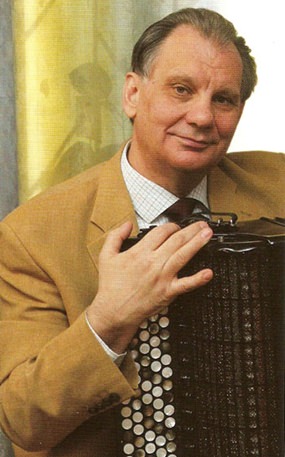What’s the difference between a macaw and an accordion? The answer is that one is loud, obnoxious and noisy; the other is a bird. The instrument has been the butt of musical jokes for years, but I once bought a piano accordion under the mistaken impression that it would be easy to play. The keyboard looks friendly enough, but there are dozens of buttons which are difficult to navigate, especially when they’re out of sight. It’s an incredibly heavy contraption too and practising requires something of a physical effort.
The other problem is that the accordion is rather loud, which is why it’s so popular in dance music. Sadly, it was not popular with my neighbours, who were clearly not connoisseurs of accordion music, at least not of the variety that I was producing. There were so many complaints that my potential as an international accordion star was never realised. In any case, I never really got the hang of working the bellows.
 Composer Viatcheslav Semionov.
Composer Viatcheslav Semionov.
After its invention in 1829, the accordion became enormously popular partly because of the contemporary craze for the polka. The instrument travelled with migrating Europeans to many parts of the world. It was ideal for folksongs and dance music not only because of its volume, but also because the so-called “Stradella bass system” enabled the player to produce bass notes and simple pre-set chords with the left hand buttons. Ironically, this was one of the reasons that the accordion was slow to be accepted into “serious” music. The breakthrough didn’t occur until the emergence of the “free-bass accordion” which instead of simple chords could play a wide range of individual notes on the left-hand manual.
Even so, acceptance was slow in classical music and the instrument was often used simply to provide local colour. The first composer to write for the chromatic accordion was Paul Hindemith in his delightfully frivolous and anarchic work entitled Kammermusik No. 1. The accordion was occasionally used in works by Shostakovich, Prokofiev, Milhaud, Kurt Weill and George Antheil.
Accordions are part of a large family of musical instruments known technically as free-reed aerophones and include mouth organs, the Chinese sheng and the Thai khaen. The melodeon and the concertina are virtually simpler versions of the accordion with a set of buttons at each end of the instrument and they’re used in many countries for traditional folk music. The bandoneon, popular in Argentina, Uruguay and Lithuania is a rather more complex concertina. The accordion was popular in Russia during the nineteenth century and it’s been estimated that by the 1870s they were producing over 700,000 instruments a year. One wonders what happened to them all.
Nikolai Chaikin (1915-2000): Concerto No. 1 in Bb Major for accordion and orchestra. Nick Ariondo (acc), Olympia Philharmonic Orchestra cond. Fung Ho. (Duration 09:55; Video 480p)
The bayan is a chromatic button accordion developed in Russia in the early twentieth century where it achieved widespread popularity. Composer Nikolai Chaikin was one of the most famous bayan composers of the former USSR and as a child, began his musical studies on the instrument.
This accordion concerto sounds pretty much how you would expect a Russian accordion concerto to sound. It’s a delightful work which falls easily on the ear and was originally composed for the bayan. It’s in a romantic late nineteenth century style, looking back to the music of Balakirev and Borodin. With a wealth of colourful melodies it’s a virtuosic work too because the composer was one of the finest performers of his day.
Nikolai Chaikin was also a well known accordion teacher and a Professor at the Gorky Conservatory and the prestigious Gnessin Academy of Music. More significantly, he was one of the first composers in Russia and Europe who introduced the accordion to the musical world as a professional concert instrument.
Viatcheslav Semionov (b. 1946): Frescoes – Concerto for accordion and orchestra. Aliaksandr Yasinski (acc), Talich Philharmonia Prague cond. Lukáš Kovaøík (Duration: 28:33; Video: 1080p HD)
Viacheslav Semionov was born in 1946 in the city of Trubchevsk which lies about two hundred miles south of Moscow. Like Nikolai Chaikin, he began playing the bayan at an early age and showed exceptional talent at the instrument. He studied at the Gnessin Academy of Music and has since given performances in more than thirty countries.
This concerto inhabits a completely different sound-world to that of Chaikin and explores themes on the spiritual development of humanity. “His major works are saturated with emotional heat”, wrote one critic, “reflecting the philosophy of the struggle between good and evil.” There’s some wonderful writing in this concerto, but give it a chance to get going. The brilliant closing section is triumphant and joyous, and the superb soloist Aliaksandr Yasinski clearly loves the work. If accordion music is not usually your cup of vodka, give this splendid concerto a try.




